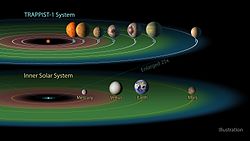User:40bus/Main Page/1
|
the free encyclopedia that anyone can edit 7,032,654 articles in English  
|
 Habitable zones of TRAPPIST-1 and the Solar System TRAPPIST-1 is a cool red dwarf star with seven known exoplanets. It lies in the constellation Aquarius about 40.66 light-years away from Earth. It has a mass of about 9% of the Sun and is estimated to be 7.6 billion years old, making it older than the Solar System. The discovery of the star was first published in 2000. Observations in 2016 from the Transiting Planets and Planetesimals Small Telescope (TRAPPIST) led to the discovery of two orbiting terrestrial planets, and five more were found in 2017. It takes the seven planets between about 1.5 and 19 days to orbit around the star. They are likely tidally locked to TRAPPIST-1, leading to permanent day on one side and night on the other. Their masses are comparable to that of Earth. Up to four of the planets orbit at distances where temperatures are suitable for the existence of liquid water (diagram pictured), and are thus potentially hospitable to life. This has drawn interest from both researchers and popular culture. (Full article...)
Recently featured:
Lamium purpureum, commonly known as the red dead-nettle, among other names, is an annual herbaceous flowering plant. Native to Eurasia, it can also be found in North America, and frequently occurs in meadows, forest edges, roadsides and gardens. It grows with square stems to 5 to 20 centimetres (2 to 8 inches) in height, and occasionally up to 40 centimetres (16 inches). The leaves have fine hairs, are green at the bottom and shade to purplish at the top, while the zygomorphic flowers are bright reddish purple. The pollen is crimson red in colour and thus very noticeable on the heads of the bees that visit its flowers. The plant contains various oils and is characterized by its high contents of germacrene D. Young plants have edible tops and leaves, which are used in salads or stir fries as a spring vegetable. The plant has also been used for many years in folk medicine and herbal remedies. This L. purpureum inflorescence was photographed in Tutermaa, Estonia. The picture was focus-stacked from 101 separate images. Photograph credit: Ivar Leidus Recently featured: Field ration – Dendrelaphis punctulatus – A Peculiar Family
|
August 2: Roma Holocaust Memorial Day
|
About Wikipedia
- Help — A general help directory about anything and everything Wikipedia
- Navigation — An explanation of wikilinks and other methods of navigating the site
- Search — A help page about how to effectively search for articles
- Editing — An explanation of how to edit articles
- Current projects — On-going projects on which editors are currently focusing
- Reference desk — Ask volunteers encyclopaedic questions about many different subjects
- Mobile access — An explanation of how to access Wikipedia from a mobile device
- Contact us — Information about how to contact Wikipedia
Wikimedia Foundation
Wikipedia is made possible by the Wikimedia Foundation, a non-profit organization that hosts a range of projects coordinated by volunteers at Meta-Wiki. The largest projects are shown below:
| Wikipedia Encyclopedia | Wiktionary Dictionary & thesaurus | Wikibooks Textbooks & manuals | |||
| Wikiquote Quotations | Commons Free media | Wikinews News | |||
| Wikiversity Learning tools | Wikisource Source texts | Wikispecies Species directory |
Each project is available in multiple languages. This is the English Wikipedia, which is one of more than 250 Wikipedias currently available. Interlanguage links, appearing in the left column by default, are used to connect a page on the English Wikipedia to other Wikipedias' pages on the same subject. If an article exists in another Wikipedia but not here in English, you can visit the Translation Department for information about requesting translations or translating articles yourself.




